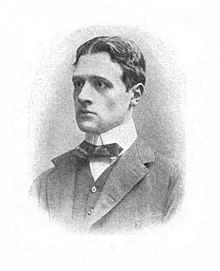Rafael Sabatini | |
|---|---|
 | |
| Born | 29 April 1875 Iesi, Italy |
| Died | 13 February 1950 (aged 74) Adelboden, Switzerland |
| Occupation | Novelist |
| Nationality | Italian / English |
| Genre | romance, adventure |
| Literary movement | Neo-romanticism |
| Notable works | Scaramouche, Captain Blood |
Rafael Sabatini (29 April 1875 – 13 February 1950) was an Italian-born British writer of romance and adventure novels.[1]
He is best known for his worldwide bestsellers: The Sea Hawk (1915), Scaramouche (1921), Captain Blood (a.k.a. Captain Blood: His Odyssey) (1922), and Bellarion the Fortunate (1926). Several of his novels have been made into films, both silent and talking.
In all, Sabatini produced 34 novels, eight short story collections, six non-fiction books, numerous uncollected short stories, and several plays.
After a brief stint in the business world, Sabatini went to work as a writer. He wrote short stories in the 1890s, and his first novel came out in 1902. It took Sabatini roughly a quarter of a century of hard work before he attained success in 1921 with Scaramouche. The novel, an historical romance set during the French Revolution, became an international bestseller. It was followed the next year by the equally successful Captain Blood. All of his earlier books were then rushed into reprints, the most popular of which was The Sea Hawk (originally published in 1915).
Sabatini was a prolific writer, producing a new book approximately every year. With his high output and well-crafted stories he was able to maintain his popularity with the reading public through the decades that followed.[1]
In the early 1940s illness forced Sabatini to slow his prolific writing. He only published three more books before his death in 1950: King in Prussia (also known as The Birth of Mischief, 1944), Turbulent Tales (a collection of shorts, 1946), and The Gamester (1949).
Rafael Sabatini was born in Iesi, Italy, to an English-speaking mother, Anna Trafford, and Italian father, Vincenzo Sabatini. His parents were opera singers who then became teachers.[1]
At a young age Sabatini was exposed to many languages living with his grandfather in Britain. He attended school in Portugal, and as a teenager in Switzerland. By the time he was 17, when he returned to Britain to live permanently, he had become proficient in five languages. He quickly added a sixth language – English – to his linguistic collection. He consciously chose to write in his adopted language, because, he said, "all the best stories are written in English".[2]
In 1905, he married Ruth Goad Dixon, the daughter of a Liverpool merchant. They had a son, Sabatini's only son, Rafael-Angelo (nicknamed Binkie). He was killed in a car crash on 1 April 1927. In 1931, Sabatini and his wife Ruth divorced. Later that year he moved from London to Clifford, Herefordshire, near Hay-on-Wye.
In 1935, he married the sculptor Christine Dixon (née Wood), his former sister-in-law. They suffered further tragedy when Christine's son, Lancelot Steele Dixon, was killed in a flying accident on the day he received his RAF wings in 1940;[3] he flew his aeroplane over his family's house, but the plane went out of control and crashed in flames right before the observers' eyes.[1]
Sabatini died in Switzerland 13 February 1950. He was buried in Adelboden, Switzerland. On his headstone his wife had written, "He was born with a gift of laughter and a sense that the world was mad", the first line of Scaramouche.[4]
Several of his novels were made into notable films in the sound era:
The 1940 film The Sea Hawk, with Errol Flynn, is not a remake but a wholly new story which just used his novel’s title.
His novel Bardelys the Magnificent was made into a famous 1926 "lost" film of the same title, directed by King Vidor, starring John Gilbert, and long viewable only in a fragment excerpted in Vidor's silent comedy Show People (1928). All but one of the reels of Bardelys were rediscovered in France in 2006, and a restoration (with production stills standing in for the missing reel) was completed in 2008.[5]
A silent version of The Tavern Knight (1920) was made in England.
A silent version of Captain Blood (1924), directed by David Smith and starring J. Warren Kerrigan, which was one of the last productions of the Vitagraph Company of America, survives in the Library of Congress, and two other silent adaptations of Sabatini novels which survive in other archives are Rex Ingram's Scaramouche (1923) starring Ramón Novarro at the George Eastman Museum, and Frank Lloyd's The Sea Hawk starring Milton Sills at the UCLA Film and Television Archive.